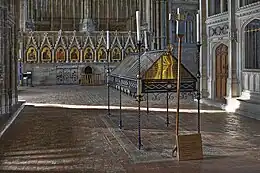
The retroquire in Winchester Cathedral.
In church architecture, a retroquire (also spelled retrochoir), or back-choir,[1] is the space behind the high altar in a church or cathedral, which sometimes separates it from the end chapel. It may contain seats for the church choir.[2]
An example of a retroquire is within Winchester Cathedral, which was built between 1200 and 1230 to house a shrine for Saint Swithun.[3]
They are usually heavily decorated, as in the case of the cathedral of Burgos, from 1498, or in the cathedral of Avila, with the tomb of El Tostado, from around 1511, but there are also simple ones, as in the New Cathedral of Salamanca, all of them found in Castilla y León, Spain.
See also
References
- ↑ Chisholm, Hugh, ed. (1911). . Encyclopædia Britannica. Vol. 3 (11th ed.). Cambridge University Press.
- ↑ "Retrochoir". Merriam-Webster. 2015. Retrieved 8 September 2015.
Definition of Retrochoir 1: the space left in a church behind the high altar or choir enclosure sometimes used as a chapel and occasionally containing a second choir enclosure
- ↑ "Our Heritage » Our History » Building the Cathedral". Winchester Cathedral. Retrieved 17 December 2019.
This article is issued from Wikipedia. The text is licensed under Creative Commons - Attribution - Sharealike. Additional terms may apply for the media files.